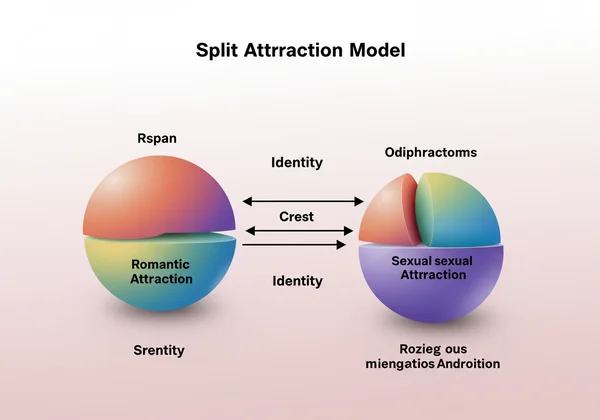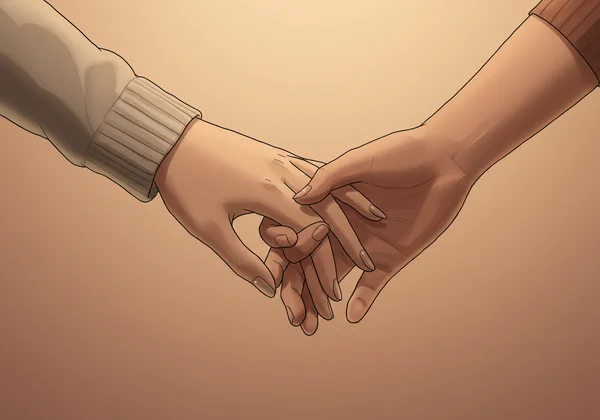Split Attraction Model: Understand Your Sexuality with a Gay Quiz
Have you ever felt confused because your romantic and sexual feelings don't seem to line up perfectly? Perhaps you feel a deep emotional connection to one gender but are physically drawn to another, or maybe you're not sure how to label your desires at all. If so, you're not alone, and there's a powerful framework that can help untangle these complex emotions. It’s called the split attraction model (SAM). Is it normal to question my sexuality? Absolutely. This guide will break down the SAM, helping you understand your unique attractions and providing clarity on your journey of self-discovery. This exploration is a personal process, and tools like a gay quiz can be a helpful first step. A thoughtful gay quiz can help frame these questions in a private, reflective space.
What is the Split Attraction Model (SAM)?
The Split Attraction Model is a framework that separates different types of attraction, most commonly romantic and sexual attraction, recognizing them as distinct experiences. Instead of viewing attraction as one single feeling, SAM proposes that who you are romantically interested in (your romantic orientation) might not be the same as who you are sexually interested in (your sexual orientation).
This concept gained prominence within asexual and aromantic communities as a way to describe experiences that didn't fit traditional models of orientation. However, its usefulness extends to everyone, offering a more nuanced and accurate language to talk about the complexities of human connection.

Why Differentiating Attraction Types Matters for Self-Understanding
Understanding the different facets of your attraction is crucial for genuine self-understanding. For many, the assumption is that romantic and sexual feelings are always intertwined and directed toward the same people. When they aren't, it can lead to confusion, isolation, or feeling "broken." The SAM validates these experiences by providing a vocabulary that affirms your feelings are real and valid. It empowers you to honor all parts of your identity without forcing them into a single, restrictive box.
Common Misconceptions About Attraction and Identity
A major misconception is that attraction is simple. We're often taught that you're either straight, gay, or bisexual, and that this one label covers everything. The reality is far more diverse. The Split Attraction Model dismantles this simplistic view, revealing attraction as a multi-layered tapestry of desires. You can be homoromantic (romantically attracted to the same gender) and asexual (experiencing no sexual attraction), or heteroromantic (romantically attracted to a different gender) and bisexual (sexually attracted to more than one gender). Recognizing this helps dismantle rigid assumptions and opens the door to greater self-acceptance.
Unpacking Romantic Attraction
Romantic attraction is about who you want to fall in love with. It’s an emotional desire for a romantic relationship with another person, often involving a deep emotional connection, intimacy, and a desire for partnership. It's the feeling that makes you want to go on dates, hold hands, share your dreams, and build a life with someone.
This type of attraction isn't necessarily tied to sex. It's about who you can see yourself with on an emotional level. To explore where your feelings might lie, a thoughtful sexuality quiz can offer personal insights.

Defining Romantic Feelings, Connections, and Desires
The core of romantic attraction is the emotional connection. It's the "crush" feeling, the butterflies in your stomach, or the deep sense of comfort and belonging you feel with someone. These desires often manifest as:
- Wanting to be emotionally close and intimate with a person.
- Daydreaming about a future together.
- Feeling a strong desire for their companionship and affection.
- Valuing their presence and emotional support above others.
Examples: From Aromantic to Panromantic Identities
Just like sexual orientation, romantic orientation exists on a spectrum. Here are a few examples:
- Aromantic: A person who experiences little to no romantic attraction to others.
- Biromantic: Romantically attracted to people of two or more genders.
- Panromantic: Romantically attracted to people regardless of their gender.
- Homoromantic: Romantically attracted to people of the same gender.
- Heteroromantic: Romantically attracted to people of a different gender.
Understanding Sexual Attraction
Sexual attraction is a desire for sexual contact or the experience of finding someone sexually appealing. It's a physical and physiological response that creates an interest in engaging in sexual activities with a specific person or type of person. While it can and often does overlap with romantic attraction, it is a distinct experience.
For some, sexual desire is a primary way of connecting, while for others, it's secondary to an emotional bond or absent altogether.

Defining Sexual Desires, Interests, and Orientations
The defining feature of sexual attraction is the interest in physical intimacy. This is what we more traditionally refer to as sexual orientation. It answers the question: "Who do I feel a physical or sexual pull towards?" This can be an immediate, visceral feeling or something that develops over time. It's important to remember that, like all forms of attraction, it's personal and unique to you.
Examples: From Asexual to Pansexual Orientations
Sexual orientation also spans a wide spectrum. Here are some common identities:
- Asexual: A person who experiences little to no sexual attraction. This directly contrasts with aromanticism and helps answer the common question of
aromantic vs asexual. - Bisexual: Sexually attracted to two or more genders.
- Pansexual: Sexually attracted to people regardless of their gender.
- Homosexual (Gay/Lesbian): Sexually attracted to people of the same gender.
- Heterosexual (Straight): Sexually attracted to people of a different gender.
How the Split Attraction Model (SAM) Can Help You Explore Your Sexuality & Identity
The true power of the Split Attraction Model is its ability to give you permission to be exactly who you are. It’s a tool for exploration, not a set of rigid rules. By using it, you can gain a deeper understanding of your internal world and find labels that feel authentic to you, rather than ones imposed by society.
If you’re wondering how these concepts apply to you, taking a free gay quiz can be a safe and private way to reflect on your feelings and see where you might land on these spectrums. For many, a gay quiz is the first time they can answer personal questions without judgment.
Validating Your Unique Feelings: Beyond "Am I Gay?"
Perhaps you've always felt "different" because your crushes and your physical desires didn't match. The SAM validates these complex feelings. It tells you that it's perfectly normal and okay to be romantically attracted to men but sexually attracted to women, or to desire a romantic partnership without any sexual component. It moves beyond simple binaries, something a well-designed gay quiz also aims to do. This validation isn't just powerful; it's liberating, transforming years of nagging confusion and anxiety into profound self-acceptance.
Beyond Simple Labels: Finding Your Specific Identity
Labels can be incredibly affirming when they fit, but restrictive when they don't. The Split Attraction Model helps you move beyond basic labels to find a more precise description of your personal identity. You might discover that a term like "biromantic homosexual" or "panromantic asexual" describes your experience far better than "gay" or "straight" ever could. This nuanced understanding allows you to articulate your identity more clearly to yourself and, if you choose, to others.
When Your Attractions Don't Align: It's Normal!
One of the most liberating aspects of the SAM is the realization that having mismatched romantic and sexual attractions is completely normal. Society often presents a neat package where everything aligns, but human experience is rarely that simple. Many people's attractions don't align, and understanding this can be a huge relief.
This is a common point of exploration for those wondering am i biromantic while feeling sexually drawn to only one gender. Your journey is your own, and every combination of feelings is valid. The key is to listen to yourself with kindness and curiosity.

Real-Life Scenarios and Shared Experiences
Consider these common scenarios:
- A woman may be homoromantic (wants to date and love women) but also bisexual (is sexually attracted to both men and women).
- A man might be panromantic (open to a romantic relationship with any gender) but asexual (feels no sexual attraction).
- A non-binary person might be biromantic and heterosexual, feeling a romantic pull to multiple genders but a sexual pull only toward a different gender.
These are just a few of the infinite possibilities. Your experience is real, and you are not alone in it.
Finding Community and Support When Questioning
Realizing your attractions are complex can feel isolating at first, but it can also open the door to new communities. Online forums, social media groups, and local LGBTQ+ centers are full of people with similar experiences. Sharing your story and hearing from others can be incredibly affirming. The first step is often personal reflection. A resource like a confidential gay test or a private gay quiz can provide a structured way to begin that reflection.
Your Journey to Self-Discovery Continues
Understanding the Split Attraction Model is not about finding a final answer, but about gaining a better tool for your ongoing journey of self-discovery. It offers a more compassionate and accurate lens through which to view yourself and others. Your attractions may be fluid and change over time, and that's okay. The most important thing is to be true to what you feel right now.
Ready to take the next step in your exploration? Our gay quiz is designed to be a supportive, non-judgmental starting point. Take our free quiz today to gain deeper insights into your own unique identity.
Frequently Asked Questions About Attraction and Identity
Is it normal to question my sexuality or attractions?
Yes, it is completely normal and healthy to question your sexuality. Identity is a journey, not a destination. Many people question their feelings at various points in their lives as they learn more about themselves and the world. Using a gay quiz can be a part of that learning process.
What's the core difference between romantic and sexual attraction?
The core difference is "heart vs. body." Romantic attraction is about who you want to be in a romantic relationship with—who you fall in love with. Sexual attraction is about who you feel a physical or sexual desire for. They can overlap, but they don't have to.
Can the Split Attraction Model help me understand if I'm gay or straight?
It can help you understand the nuances behind those labels. For example, you might realize you are both homoromantic and homosexual, which aligns with the traditional definition of "gay." Or, you might find your identity is more complex. It's a tool for clarity, and a confidential gay quiz can help you explore your unique feelings. You can take a gay quiz online to see how these concepts apply to you.
What if my romantic and sexual attractions don't align?
That is perfectly okay and valid! Many people experience this. It doesn't make your identity any less real. The Split Attraction Model was created specifically to give language to and validate these exact experiences.
Where can I learn more about my specific sexual or romantic identity?
A great place to start is with introspection in a safe, private environment. Using an anonymous tool like our LGBTQ quiz or a specific gay quiz can help you reflect on your feelings without pressure. From there, online resources from organizations like The Trevor Project or GLAAD can provide more information and community support.